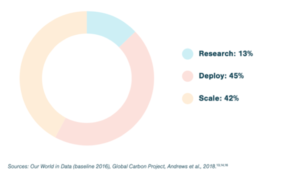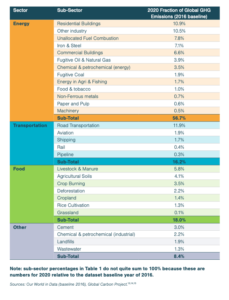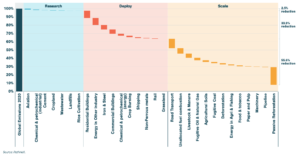
Decarbonizing the global economy at first glance looks like an overwhelming task, given that greenhouse gas (GHG) emissions come from everywhere – every product, technology, industry, service, and sub-sector. But at RethinkX, based on our insights into the interface between societal change and technology disruptions, we have found that this challenge can be met rapidly and effectively with a focused approach. That’s because the bulk of emissions – over 90% – can actually be grouped around 3 major sectors: energy, food, and transportation.
This insight is crucial: it means that rather than a ‘whack-a-mole’ or ‘all of the above’ strategy targeting all manner of different issues without a clear sense of what should be prioritized and when, we need to focus our efforts on the transformation of these three key sectors. And we can do that by prioritizing the deployment of a specific set of existing technologies. This focused approach allows us to take the fastest and most strategic approaches, knowing when to leverage the power of markets, and when best to leverage the capabilities of governments.
This blog presents a summary of the RethinkX report Rethinking Climate Change by James Arbib, Adam Dorr, and Tony Seba (published on Aug 4, 2021).
2020 Global Greenhouse Gas Emissions by sector and subsector
As governments, NGOs, businesses, and trade unions gather at COP26, the UN Climate Change Conference, at the end of October to determine the global path forward for climate change mitigation, the above table provides a useful breakdown of which sub-sectors should receive urgent priority to achieve the greatest emissions reductions, and which should not. The danger of an all-of-the-above approach is that societies divide their time, attention, and resources amongst a large number of different emissions reduction strategies with no real sense of their systemic interrelationships. This is counterproductive and will produce sub-optimal results at best.
Our analysis shows that the most effective approach is to concentrate on one single strategy: Deploy and scale existing technologies to disrupt the energy, transportation, and food sectors as quickly as possible.
Instead of working through each sub-sector and trying to think through sub-sector specific solutions (e.g. how do we decarbonize steel, or how do we decarbonize cement?), a suite of existing technologies offers the opportunity to disrupt these sectors wholesale, driving fundamental transformations that will, in turn, lead to new dynamics at the sub-sector level within those sectors (i.e. with the energy sector transformed, this will, in turn, disrupt the way buildings and industries are powered).
The Eight Keys
While the current incumbent energy, transportation, and food sectors of the economy are incredibly carbon-intensive, three major disruptions are already unfolding in the 2020s that will decarbonize, decentralize, and democratize each of these major sectors.
Solar, wind, and batteries (SWB) will disrupt coal, oil, and gas. Autonomous electric vehicles (A-EVs) providing transportation-as-a-service (TaaS) will disrupt internal combustion engines and private vehicle ownership. And precision fermentation and cellular agriculture (PFCA) will disrupt meat, milk, and other animal products.
These eight key technologies are either already at market and able to scale immediately, or ready to begin deploying to market. Together, they will mitigate more than three-quarters of global GHG emissions. Even more extraordinary will be the interconnected cascading effects of these disruptions, which will open up some ‘big surprises’ by making previously unfeasible carbon withdrawal approaches affordable.
Our previous research has shown that disruptions of the energy, transportation and food sectors are inevitable, and are being driven by purely economic factors: but exactly how they unfold, as well as how slow and how rapidly – and their wider societal implications – are not set in stone. The path we take and our prospects for addressing climate change will depend on the societal choices we make, including those made on our behalf by our world leaders.
Decarbonization Readiness – A guide
Here, and in our report, Rethinking Climate Change, we provide a guide for decision-making based on how to prioritize our efforts to maximize mitigation benefits as soon as possible by categorizing sources of emissions according to three stages of mitigation readiness: Research, Deploy, and Scale. The optimal choices and actions that investors, policymakers, civic leaders, and other decision-makers should take is different depending on each readiness stage – as reflected in the names of the stages themselves.
Each sub-sector of the global economy will be affected by the disruption of energy, transportation, and food differently, and the decarbonization readiness stage chosen corresponds to the maturity of the technologies required to mitigate emissions from that sub-sector. These technologies include not just SWB, A-EVs and TaaS, and PFCA, but any other additional technologies required for decarbonization.
Emissions Reductions by 2035 by Decarbonization Readiness Stage (‘Be Sensible’ Scenario)
Research Stage
Mitigation technologies still require research and/or substantial progress to reach commercial viability.
Technologies categorized in the subsectors of the Research Stage are expected to experience a considerable lag in decarbonization because technological advancement is still required. In ‘Aviation’, for example, while SWB will eventually be able to facilitate the generation of clean fuel, deployment still needs to scale while electric aircraft and energy storage also need to progress significantly before this becomes viable.
This stage also includes sub-sectors such as cement, rice cultivation and wastewater where there are few if any technologies currently on the horizon that would allow them to achieve full decarbonization.
As a result, for subsectors in this stage – which make up just 13% of 2020 global GHG emissions –
Governments should:
- Provide funding to support R&D.
Private investors should:
- Provide funding to support R&D.
Deploy Stage
Mitigation technologies have been validated and are ready for deployment but must be refined through experience to become competitive.
These subsectors may experience a slight lag in decarbonization because technologies other than SWB, A-EVs and TaaS, and PFCA are required to effectively decarbonize the sector. No further research is required to apply these additional technologies, but they are not yet widespread.
Residential heating, for example, is in the Deploy stage because it not only requires SWB to supply clean energy, but also needs induction cooktops to replace gas stoves, electric water heaters to replace gas water heaters, and electric heat pumps to replace gas furnaces and oil-fired boilers to be effective.
Similarly, iron and steel, in addition to SWB requires electrification of the industrial heating processes and alternatives to carbon from coke as reducing agents.
As a result, for subsectors in this stage – which make up about 45% of 2020 GHG emissions –
Governments should:
- Help design efficient markets with judicious use of regulations, standards, mandates, and prohibitions.
- Provide temporary supports and subsidies to accelerate the phase-in of the new technologies (e.g. electrification for heating).
Private investors should:
- Risk tolerant private investors should finance early growth and refinement to help take the technologies to market.
Scale Stage
The technologies needed to decarbonize the subsector are already deployed and ready to scale.
These subsectors should not experience a lag because decarbonization will run directly parallel to the disruption itself, since no additional technologies are required beyond SWB, A-EVs, and TaaS, and PFCA driving the three disruptions
For example, virtually all emissions from fugitive oil and gas will be directly eliminated by the energy and transportation disruptions without requiring additional technologies. Hence, we categorize this sub-sector as ‘ready to scale’ because the technologies required for decarbonization – SWB, A-EVs, and TaaS – are already being deployed to market. Technologies at this stage do not require state subsidies, but instead can be accelerated merely by ensuring that markets offer a level playing field.
As a result, for subsectors in this stage – which make up about 42% of 2020 GHG emissions –
Governments should:
· Remove market barriers.
· Break up existing monopolies.
· Guarantee consumers’ rights to produce and trade with the new technologies.
· End existing protections for incumbent industries based on older technologies.
· Ensure protections and opportunities for people in these industries to transition to the disruptive industries.
Private investors should:
· Finance deployment as the disruption takes off
This is excellent news…
The implications of the preceding analysis are remarkable: as much as 87% of global emissions today come from sub-sectors that are already in either the Scale or Deploy stages. This means that mitigation of these emissions can be driven largely by leveraging market forces.
Share of 2020 Global GHG Emissions by Decarbonization Readiness Stage

The overwhelming majority of emissions reductions that are achievable by 2035 (‘Be Sensible’ scenario) come from sub-sectors that are either ready to be decarbonized directly by scaling SWB, A-EVs and TaaS, and PFCA, or that are ready to be deployed to market and can quickly graduate to the Scale stage if supported by the right choices and actions from governments, investors, and other decision-makers.
This demonstrates that most of the key technologies do not require subsidies as they are already scaling. This implies that subsidies should not be directed at such technologies, including for instance at car charging infrastructure which falls into the ‘scale’ stage. However, as shown, targeted subsidies will be important instead for technologies in the ‘deploy’ stage, such as electrification of heating and industry. Simultaneously, there is no need to contemplate wholesale ‘carbon taxes’: instead, existing onerous subsidies to incumbent carbon-intensive industries should simply be removed.
This is not a one-problem solution
Our findings confirm that decarbonization is not a burdensome and expensive drag, but a massive economic opportunity. The specific cost and capability improvements in SWB, A-EVs, TaaS, and PFCA in the energy, transportation, and food sectors will provide for the first time in history the capacity to do more and more, with less and less, due to the paradigm shift they entail in the fundamental architecture of the production system. Economic, social, and environmental incentives and goals will be realigned by these clean technologies and rebound effects notwithstanding, they represent a major step toward the ultimate goal of meeting human needs sustainably.
By leveraging the power of market forces, and strategically focusing government action, mitigation of greenhouse gas emissions can be transformed from a costly expense into a lucrative investment at every scale from local to global. It is imperative that everyone present at the UN Climate Change Conference understands that regions, nations, communities, cities, businesses, and investors who choose to embrace and lead the disruptions rather than resist them, will reap enormous economic and social rewards, as well as extraordinary environmental benefits.
This also means that governments do not need to impose draconian restrictions on either the supply or the demand side of the economy, which in turn avoids the social harms of austerity policies that reduce standards of living and impede human development (the burden of which falls disproportionately on those communities and nations that are already disadvantaged). Indeed, economic contraction in the context of the incumbent system would only slow down the disruptions of the energy, transportation, and food sectors, and delay the achievement of net-zero emissions. Governments, companies, organizations, and individuals who wish to reduce emissions should therefore focus on accelerating the adoption of SWB, A-EVs, TaaS, and PFCA, rather than on austerity.
As the manifest economic, geopolitical, and social opportunities of the disruptions, along with the risks of ignoring them, becomes ever clearer, many actors will seek to accelerate their own transformation for reasons beyond climate mitigation alone. Some may do so to mitigate dependence on imported fragile food and energy supplies, while others may recognize the political capital and other benefits to be gained by leading rather than resisting the disruptions. As different actors seek to accelerate the disruptions in their own context to avoid risks or capture a first-mover advantage, the ensuing race to the top will generate further powerful accelerating feedbacks that will compound the speed and scale of disruptions worldwide.
With a focused, deliberate approach we can achieve net zero emissions much more quickly than is widely imagined without collateral damage to society or the economy. We can use market forces as the dominant driver to reduce emissions. We can save and not waste trillions of dollars. We will no longer need to trade off the environment for the sake of the economy. And the dividends of decarbonization will be revolutionary: we will be empowered to narrow, not widen, the gap between wealthy and poor communities, and developed and less-developed countries.



Dear RX team,
I’m all in. You had me at “Clean Disruption” in 2014. So it’s really gratifying to see it all amassed into a cohesive plan in the last few weeks.
But I keep sensing something missing, and I think it’s a name, a descriptor. We have “Green New Deals’ and “Project Drawdowns”, “30 X 30” and “50 X 40” , but yours is hands-down the logical choice, and the public needs to grasp it soonest. Leave it up to you for the solution, and thanks for showing us the way.
Living in Alberta Canada, this article opened my eyes when it declared that “Carbon Taxes” are NOT needed. My natural gas driven HVAC in my condo will see annual carbon taxes rise to nearly $1,000 per resident by 2030 when the carbon tax hits roughly $10/GJ. The problem is that replacement HVAC systems & energy efficiencies in condos are somewhere between Research/Deploy Stage. Uninformed decision makers will break system. I hope RethinkX can get in front of COP26 with their ideas.
Dear RX team,
Thanks for sharing your vision on mitigating climate change. My question is: will your approach deliver in-time the required emission reductions while avoiding Jevon’s paradox without substantial carbon pricing?